#16th century spanish clothing
Explore tagged Tumblr posts
Text

New Reference sheet + design update for Sāwol! (Also a teaser to Caleb's updated design!)
Little man runs around in a loincloth/cape most days. When she catches him doing that, Elvira thinks it's disgusting and a sign of his "salvaie" (salvaje). So she'll force him to wear something more "appropriate" (despite the fact it is usually 90+ F with 80% humidity). The (very) few times he's left the brush and gone into the city, Demetre will have him wear regular children's clothes and an eyepatch (to hide his star) so he blends in a bit more.
(I hope the quality hasn't been utterly shit on. It looks like it in the preview I get...)
#my art#furry#furry art#oc#my oc#mesoamerica#character reference#reference sheet#16th century spanish clothing#16th century#1500s#child#child character#original character
1 note
·
View note
Text

tr: In 1553, Torquemada complained about the changes in fashion in these words: when a man thinks he's dressed for ten years, not one is past when another new style comes, that makes one take heed, and what was well done goes on to be undone and mended, taking off and putting on... so that the fashions and inventions of each day distress the people and ruin their estates.
Carmen Bernis Madrazo, Indumentaria española en tiempos de Carlos V.
#me when i'm wearing clothes i bought in 2015 because i don't wish to ruin my estate#rip torquemada you would have loved fast fashion#fashion history#16th century#spanish history
10 notes
·
View notes
Text

Elisabeth of Valois, Queen of Spain
Artist: Alonso Sánchez Coello (Spanish, 1531/1532-1588)
Date: c. 1560
Medium: Oil on canvas
Collection: Kunsthistorisches Museum Vienna, Austria
Description
Elizabeth of Valois (1545–1568) was the daughter of King Henry II of France. As a result of the peace treaty signed between France and Spain in 1559, she became the third wife of King Philip II of Spain, although she had previously been engaged to marry his eldest son, Don Carlos.The distance required in a court portrait between the subject and the viewer is enhanced by the magnificence and stiffness of the richly embroidered clothing.
#portrait#fine art#painting#oil on canvas#elisabeth of valois#queen of spanish#spanish monarchy#standing#costume#richly embroidered clothing#gloved hand#handkerchief#embroidery#head piece#lace#window#spanish history#alonso sanchez coello#spanish painter#spanish culture#oil painting#16th century painting#artwork#european art#spanish art
3 notes
·
View notes
Text
I am. The nichest of niche interest people. History from this specific date range? No. History of a specific group in that specific date range. Niche hobby? Nope, niche technique from niche hobby. Niche show? Nicher.
2 notes
·
View notes
Text
Word List: Fashion History
to try to include in your poem/story (pt. 3/3)
Pelete Bite - a fabric created by the Kalabari Ijo peoples of the Niger Delta region by cutting threads out of imported cloth to create motifs
Pelisse - a woman’s long coat with long sleeves and a front opening, used throughout the 19th century; can also refer to men’s military jackets and women’s sleeved mantles
Peplos - a draped, outer garment made of a single piece of cloth that was worn by women in ancient Greece; loose-fitting and held up with pins at the shoulder, its top edge was folded over to create a flap and it was often worn belted
Pillow/Bobbin Lace - textile lace made by braiding and twisting thread on a pillow
Pinafore - a decorative, apron-like garment pinned to the front of dresses for both function and style
Poke Bonnet - a nineteenth-century women’s hat that featured a large brim which extended beyond the wearer’s face
Polonaise - a style of dress popular in the 1770s-80s, with a bodice cut all in one and often with the skirts looped up; it also came back into fashion during the 1870s
Pomander - a small metal ball filled with perfumed items worn in the 16th & 17th centuries to create a pleasant aroma
Poulaine - a shoe or boot with an extremely elongated, pointed toe, worn in the 14th and 15th centuries
Raffia Cloth - a type of textile woven from palm leaves and used for garments, bags and mats
Rebato - a large standing lace collar supported by wire, worn by both men and women in the late 16th and early 17th century
Robe à L’anglaise - the 18th-century robe à l’anglaise consisted of a fitted bodice cut in one piece with an overskirt that was often parted in front to reveal the petticoat
Robe à la Française - an elite 18th-century gown consisting of a decorative stomacher, petticoat, and two wide box pleats falling from shoulders to the floor
Robe en Chemise - a dress fashionable in the 1780s, constructed out of muslin with a straight cut gathered with a sash or drawstring
Robe Volante - a dress originating in 18th-century France which was pleated at the shoulder and hung loose down, worn over hoops
Roses / Rosettes - a decorative rose element usually found on shoes in the 17th century as fashion statement
Ruff - decorative removable pleated collar popular during the mid to late 16th and 17th century
Schenti - an ancient Egyptian wrap skirt worn by men
Shirtwaist - also known as waist; a woman’s blouse that resembles a man’s shirt
Skeleton Suit - late 18th & early 19th-century play wear for boys that consists of two pieces–a fitted jacket and trousers–that button together
Slashing - a decorative technique of cutting slits in the outer layer of a garment or accessory in order to expose the fabric underneath
Spanish Cape - an outer wrap often cut in a three-quarter circle originating from Spain
Spanish Farthingale - a skirt made with a series of hoops that widened toward the feet to create a triangular or conical silhouette, created in the late 15th century
Spencer Jacket - a short waist- or bust-length jacket worn in the late 18th and early 19th centuries
Stomacher - a decorated triangular-shaped panel that fills in the front opening of a women’s gown or bodice during the late 15th century to the late 18th century
Tablion - a rectangular panel, often ornamented with embroidery or jewels, attached to the front of a cloak; worn as a sign of status by Byzantine emperors and other important officials
Toga - the large draped garment of white, undyed cloth worn by Roman men as a sign of citizenship
Toga Picta - a type of toga worn by an elite few in Ancient Rome and the Byzantine Empire that was richly embroidered, patterned and dyed solid purple
Tricorne Hat - a 3-cornered hat with a standing brim, which was popular in 18th century
Tupu - a long pin used to secure a garment worn across the shoulders. It was typically worn by Andean women in South America
Vest/Waistcoat - a close-fitting inner garment, usually worn between jacket and shirt
Wampum - are shell beads strung together by American Indians to create images and patterns on accessories such as headbands and belts that can also be used as currency for trading
Wellington Boot - a popular and practical knee- or calf-length boot worn in the 19th century
If any of these words make their way into your next poem/story, please tag me, or leave a link in the replies. I would love to read them!
More: Fashion History ⚜ Word Lists
#word list#fashion history#writeblr#dark academia#terminology#spilled ink#writing prompt#writers on tumblr#poets on tumblr#poetry#literature#light academia#fashion#lit#studyblr#langblr#words#linguistics#history#culture#creative writing#worldbuilding#writing reference#writing resources
128 notes
·
View notes
Text
I think there is always a problem with Anne Baleyn's locker room in almost any production. It is always the worst dressed among the six queens. Just look at The Six Wives of Henry VIII of 1970

The other wives wear appropriate dresses to the time that is set the series, Catalina de Aragon wears a Spanish fashion dress from the beginning of the 16th century, and Jane Seymour wears a modest green dress as a company lady according to 1636. What do you wear Anne? A series of high fantasy or Elizabethan dresses.



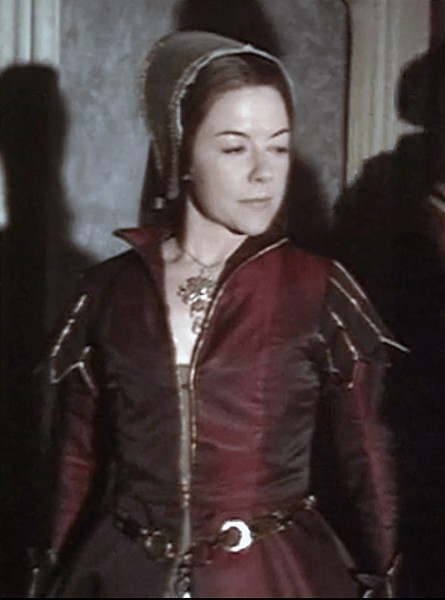
I give a pass to this dress, not only because it is pretty but because Anne is wearing it in a dysphrase dance.
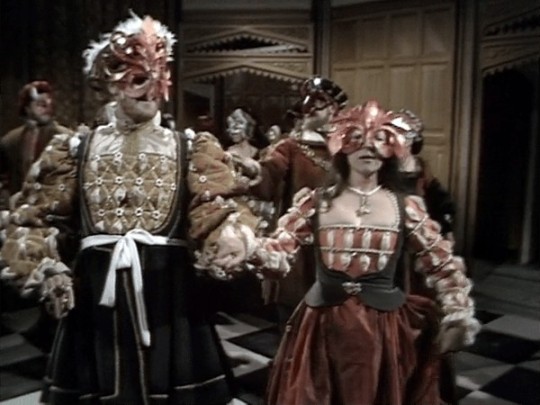
But what about the rest of dresses? Anne became popular in the English court for her great ingenuity and glamorous French style. Henry the height of gifts during and his commitment, and the Baleyn were not poor. Why is your clothes so pesticary? Let's compare with Jane Seymour, who has a similar story. To start the Seymour were much less prosperous than the Baleyn, Jane's father, John Seymour was appointed gentleman on the battlefield by Enrique VII for his services against the rebels of Cornwall in Blackheath on June 17, 1497. Then he was appointed Caballero Banneret in 1513 after the battle of the Spurs. But outside those honors, the family had not risen much. Thomas Baleyn instead had served Enrique VII and had been in the entourage of Margarita Tudor when she went to Scotland. He was appointed Biscount for his own merit in 1525, even before Ana had met Enrique VIII. He was also heir to Ormond County thanks to his mother. Elizabeth Baleyn of single Howard, was the sister of the Duke of Norfolk. With only that information, it shows that the Baleyn were also much richer than the Seymour, apart from having a major noble status, which should be reflected in the clothes they wear.
If we see in the same adaptation, in your home Wolf Hall Jane uses a historically precise country attire, which shows the simplicity and modesty of Jane but also that the Seymour are not so rich to allow them to use the whole day silk but they are still noble to be made of good quality and dyed wool.
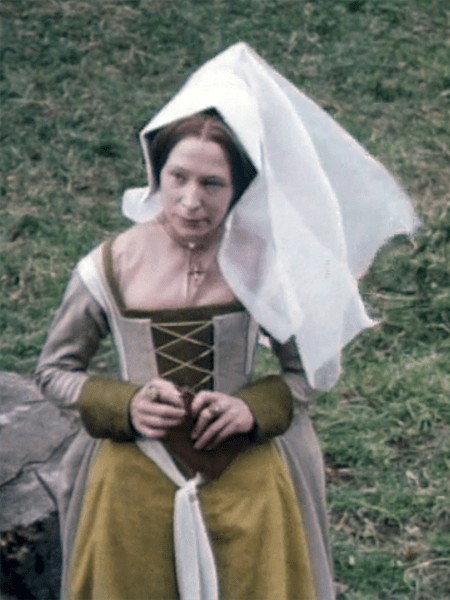
His second outfit, when he attends the Court, is more fashionable and is elegant, but it is still simple and modest, reflecting Jane's personal tastes and that his family being low nobility, but the sumptuous laws, he is not going to Cover of jewelry.
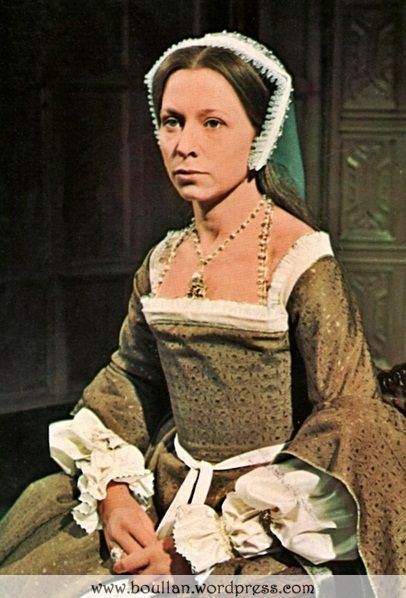
Once he became a queen, Jane's dress improves, she is still pale but is very adorned with jewelry, wears an elaborate two waters unlike the French headdress of her predecessor.

The costume designers managed to tell the story of the most boring of Henry VIII's wives, through her clothes. Showing her evolution from the spinster daughter of an unimportant knight, to a lady-in-waiting courted by the king to the queen of England; wonderfully, with beautiful designs that look like they're from the Tudor era. Why can't they do the same with Anne?
The worst thing is that this is repeated constantly, in one of the most recent series based on the reign of Henry VIII, with a wardrobe that is almost exact to the historical period in which the events take place, "Wolf Hall". Okay, the series is from Cromwell's perspective, so they're not going to show us Anne's life before she got mixed up with the secretary's. Anne is already the future wife of the king when she appears. But when she is queen, her clothes only change color; there are no more jewels, no better fabrics, no embroidery and her hood is horrible. Just compare her pink dress that according to her designers is that of "The daughter of a simple gentleman" vs her clothes as queen when she can use better dyes.



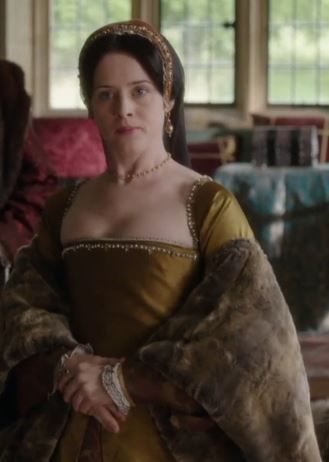
They are practically the same, I know that Anne is at that time Henry's girlfriend, but why is her clothing so simple even when she is the queen of England? There are no other jewels on her neckline, she wears no necklaces other than a pearl choker. Why are her dresses not made of silk, brocade and damask, with embroidery? This problem does not exist with Jane Seymour

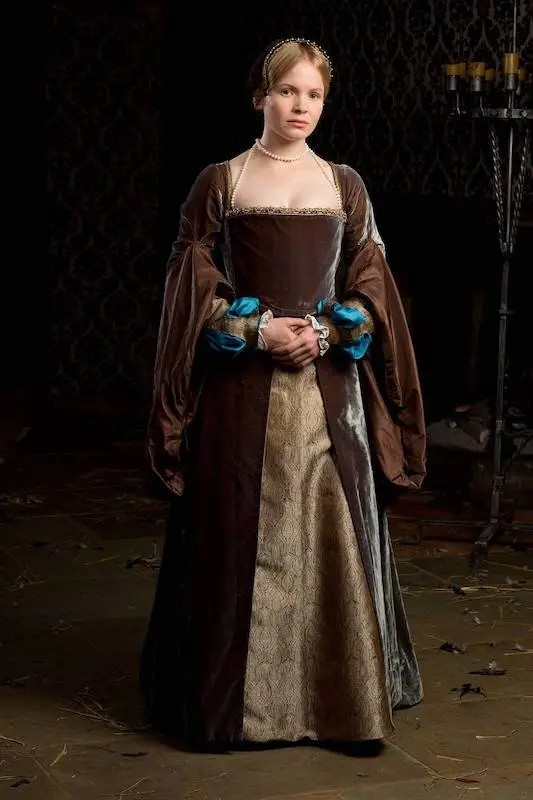
Her dresses as a lady-in-waiting, reflect her reserved, simple and modest nature. Her clothes and hood are decorated with simple lace and embroidery, not with jewels unlike other noble ladies. The colors are monotonous but with some color inside, almost saying that the lady may look bland on the outside but on the inside she is a force to be reckoned with. She seems to be the spinster daughter of an unimportant family at the moment.
When Henry visits Wolf Hall, Jane wears a dress that is too simple for a visit from a king, but it gives a good idea of what a lesser noblewoman would wear in her home.
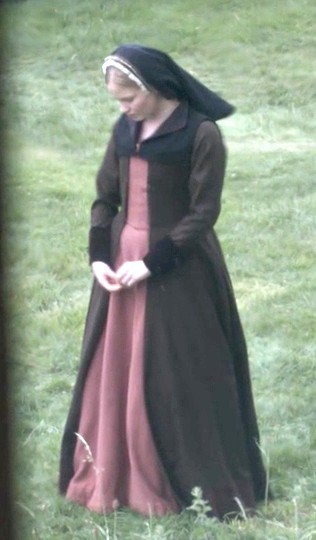
As queen, Jane's clothes become more luxurious; more sumptuous fabrics, lavish jewelry and elaborate English headdresses. Rich but conservative, suitable for Queen Jane's character as peacemaker in the English court.


Is it very difficult to do the same with Anne Boleyn? Even in other productions, such as The Other Boleyn Girl, which try to narrate the rise in status and evolution of Anne Boleyn, they repeat the same mistake: the Queen of England continues to dress like a knight's daughter! It's even worse than in Wolf Hall, where at least Anne uses dyes reserved for royalty in The Other Boleyn, she uses the same color palette throughout the film.
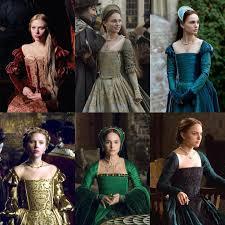
There is no big change in her way of dressing, wait there is. Anne stopped wearing horrible dresses that don't look like they were from the Tudor period in England, like that blue dress with a circle print that looks more Italian and the "Cranach" suit. Seriously, the designers forgot that if the Boleyn girls had foreign influence in their clothing, it was French because they both served as ladies-in-waiting in France, not Italy or Germany. Honestly, the only dress in my grade is Anne's green dress.
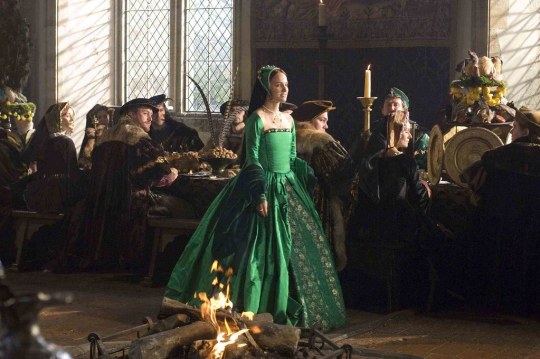
This is the look of the woman who became a star at the English court. The fabric is green silk or satin, her French hood looks like a French hood and not a Russian tiara. She wears the iconic gold B necklace. It is elegant, sumptuous and French, the look of a Viscount's daughter. The problem is that by attracting Henry's attention, Anne's clothes do not continue to improve, she does not try to look like the real Queen of England, she continues to dress like a simple noblewoman. Only when she is tried and executed, the designers give her clothes that royalty would wear.
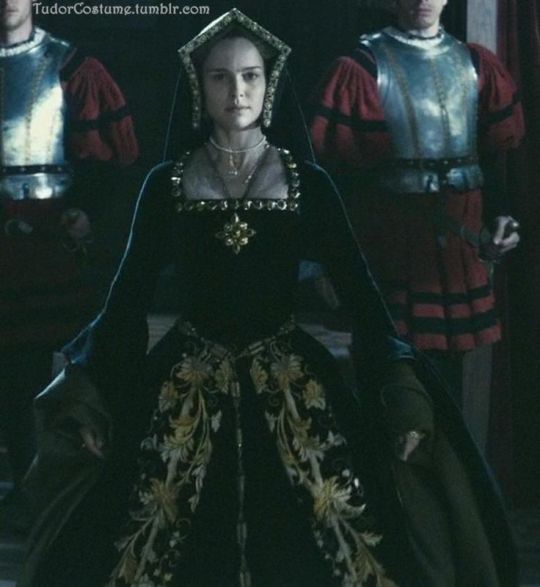
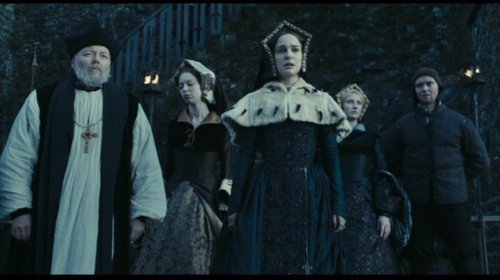
The only adaptation based on the life of Anne Boleyn that manages to narrate the evolution of the character through her clothes is Anne of The Thousand Days. Sure, there are some questionable fabric choices, Russian tiaras, lace-up closures in the back, and the belief that Anne only had the pearl necklace with the gold B. But the designs are so pretty that you don't care.
We are introduced to Anne at court dancing with Henry Percy, she wears a beautiful light green damask dress, a gold choker and a French hood. Her look is simple but elegant and fashionable, fitting for the daughter of a notable noble family.
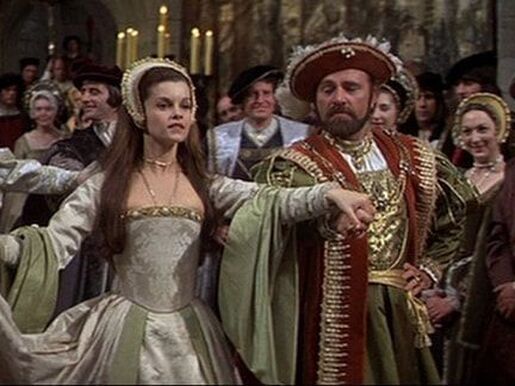
It's no wonder Henry is drawn to her.
At home at Hever Castle, Anne wears a yellow dress, the design is simpler than the one worn at the court ball; the sleeves are wrist-length and there are no jewels at the neckline. But it's made of satin with embroidery, still an expensive but more casual dress. Befitting someone of Anne's social standing, she is not a princess by birth like Catherine of Aragon, but her family is of higher status than Jane Seymour's, the Boleyn girl's clothes are always going to be better at court and in her home than the pale Seymour girl's clothes.
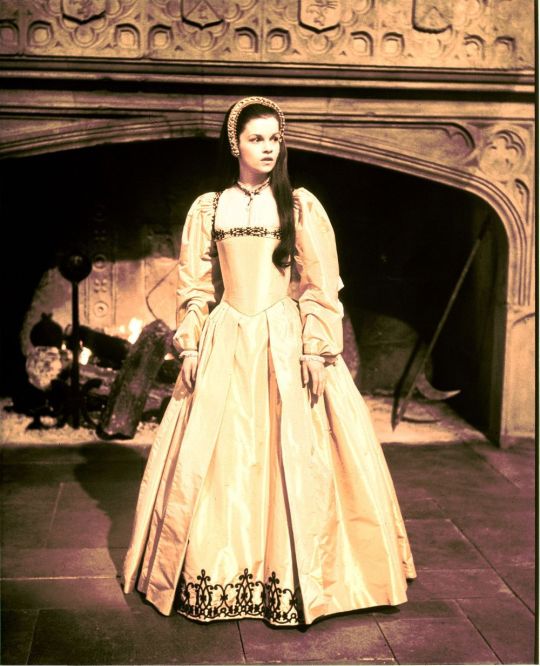
Back at court, now in the king's favour, Anne wears a more elaborate dress and headdress, accessorising with a gold brooch and a jewelled girdle. All gifts from Henry VIII.

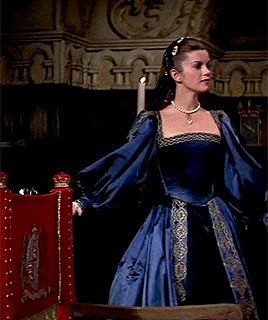
She later wears this to dinner with the king, a dress of beautiful blue velvet with gold embroidery. Her hair is loose and decorated with jewels.
As queen she wears a dress of silver and gold brocade. And at a dance a white dress with silver embroidery and pearls and diamonds sewn into the bodice.

She maintains her queenly appearance even when judged, but the colors are somber.
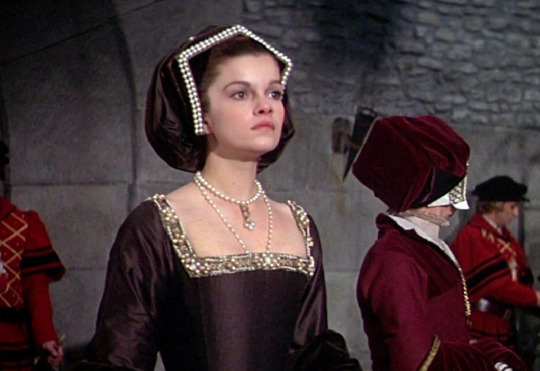
At her execution, her clothing is devoid of ornamentation, simple and dark, very different from the historical Anne who died looking like a queen. But it is understood that she has been stripped of all her power and influence.
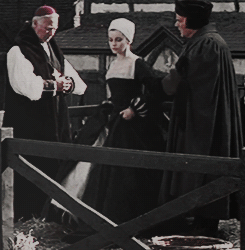
This is how Anne's journey should be told, as she rises, her clothes get better. If I were in charge of Anne's wardrobe, I would have her wear designs similar to those in Wolf Hall and the green dress from The Other Boleyn Girl. At home and as casual wear, her clothes would be similar to the yellow dress from Anne of The Thousand Days. Once she starts being courted by Henry, she would continue to enrich her clothes until she reached her highest point as queen. Basically like Jane Seymour but prettier and French style.
#anne boleyn#the six wives of henry viii#the other boleyn girl#the tudors#anne of the thousand days#wolf hall#wolf hall the mirror and the light#the mirror and the light#jane seymour#katherine of aragon#mary boleyn#henry viii#henry tudor#elizabeth tudor#mary tudor#fashion#tudor fashion#fashion history
67 notes
·
View notes
Text
Steel Brocade: Puffed & Slashed Costume Armor
Surviving to this day in the collections of the world’s most illustrious museums are a group of three armors. These armors have much in common, but most striking is the attempts made by their armorers to render in steel a convincing portrayal of the puffed and slashed clothing fashionable to the early 16th century.
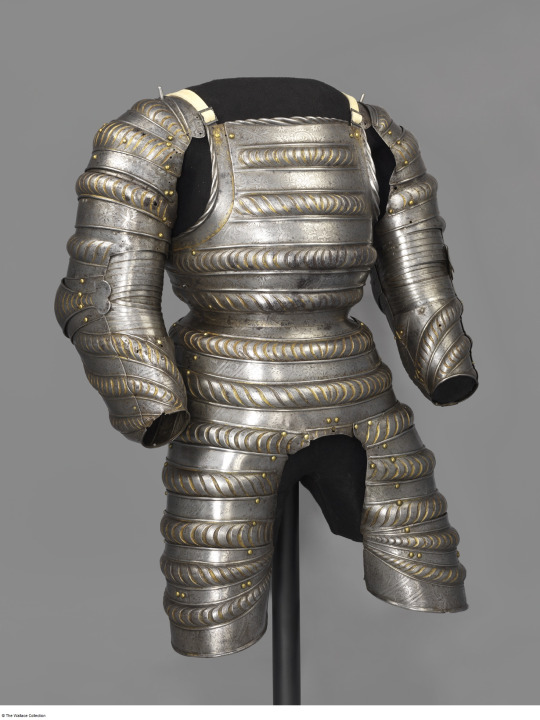

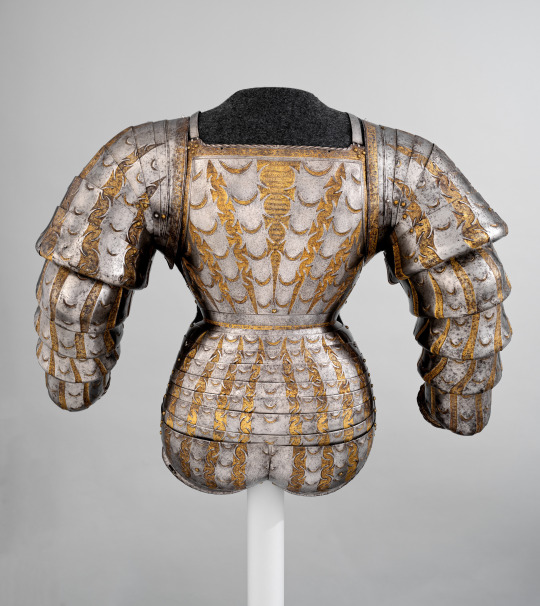
Though this fashion is synonymous with the landsknecht mercenaries who may have been responsible for popularizing it, the puffed and slashed style was enjoyed by members at all levels of society.
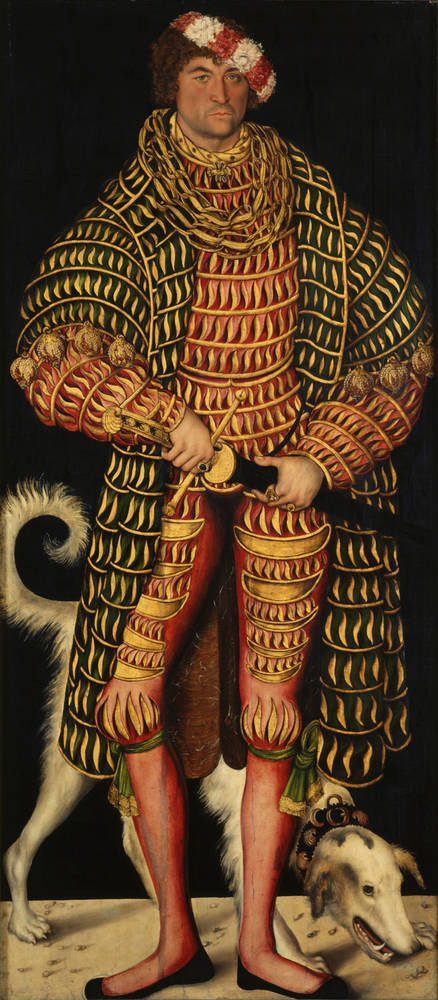
Portrait of Duke Henry of Saxony by Lucas Cranach the Elder, 1514, Staatliche Kunstsammlungen, Dresden.
The earliest of these three armors is housed at the Wallace Collection. Consisting only of a cuirass and arms, this armor is, at first glance, rather underwhelming when compared with the other armors in this group. Though the embossed bands styled with etched slashes embellished with gold provide the impression of a puffed and slashed doublet, the execution is all rather stiff, and lacks the impressive volume and fullness exemplified by the other armors.

It is for this reason that this armor, previously considered contemporary to the KHM and Metropolitan examples, has received relatively little attention. However, recent scholarship by Dr. Tobias Capwell suggests that this work is not, indeed, contemporary to the other examples, and is rather about ten years older, dating to ca. 1515. Dr. Capwell also considers this piece to be the work of Konrad Seusenhofer, a favored armorer of the Emperor Maximilian I.
Seen through this lens, not as a poorly executed contemporary of greater armors, but as a less developed ancestor to them, this armor takes on new life. It speaks to innovation and experimentation; an early attempt at a technique which would later be perfected.
The second in this line is the garniture of Wilhelm von Rogendorf, housed at the Kunsthistorisches Museum in Vienna.

This armor is unique for its condition, which is remarkably good. Not only does this armor retain more of its pieces than the other two, it is also accompanied by a number of “pieces of exchange,” elements which could be swapped out so the armor could be worn in the field.
Finished in 1523, as attested to by the date etched on the right shoulder strap, this armor was made for the Count Wilhelm von Rogendorf by Kolman Helmschmid and etched by Daniel Hopfer.

Wilhelm von Rogendorf himself was heir to a new, up-and-coming German noble family.

A medal showing Wilhelm von Rogendorf as a Knight of the Order of Calavatra, dated 1536, Kunsthistorisches Museum, Vienna.
Born in 1481 the second son of Kaspar von Rogendorf, Wilhelm became heir to his family’s estates when his elder brother Sigmund died in 1507, by which time Wilhelm was already a courtier at the Habsburg court. He entered into the service of King Charles I of Spain (later Emperor Charles V) no later than 1517 and was appointed Governor of Friesland. In 1522, Wilhelm accompanied Charles to Spain where he commanded a regiment of 4,000 landsknechts and was again placed in charge of a restless border territory. In 1524, he successfully captured the Fortress of Fuenterrabía from the French, which won him great praise from the Emperor. Shortly thereafter, Wilhelm was named Captain of the Imperial Bodyguard and given the governorships of Catalonia, the Cerdagne, and the Roussillon. Additionally, he was appointed to the Spanish chivalric Order of Calavatra. Wilhelm would retire from court in 1539, but would be recalled in 1541 to command Imperial troops against the Ottomans in Hungary. He would be killed later that same year at the siege of Buda by a stray cannonball.
Though Wilhelm’s armor is now displayed in its parade configuration, the surviving pieces of exchange attest to the fact that it was also an armor for combat. The cuirass is equipped with the long tassets common to the early 16th century. A pair of holes can be observed at the top of the last lame.

These holes correspond to holes at the top of the half-cuisses which accompany this armor, showing that these cuisses would be pointed to the tassets rather than worn separately.

In the rear, the cuirass is accompanied by a rump-defense, also known as a hoguine. Small turning pins near the waist allow this to be removed for combat.
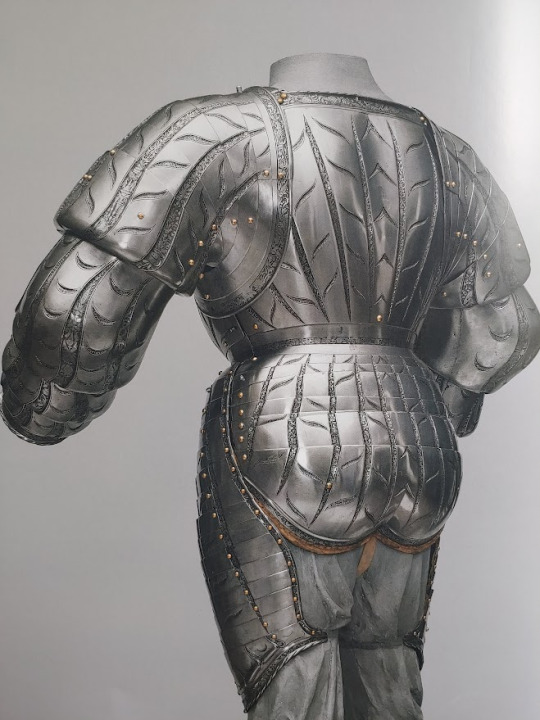
Both spaulders
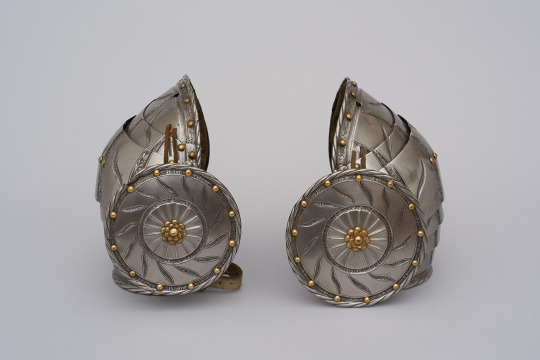
and gauntlets

survive. Additionally, the KHM retains the armor’s right vambrace
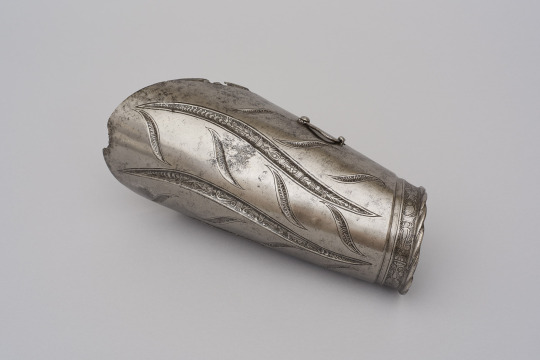
while the Wallace Collection holds the rerebrace and couter for the left arm.
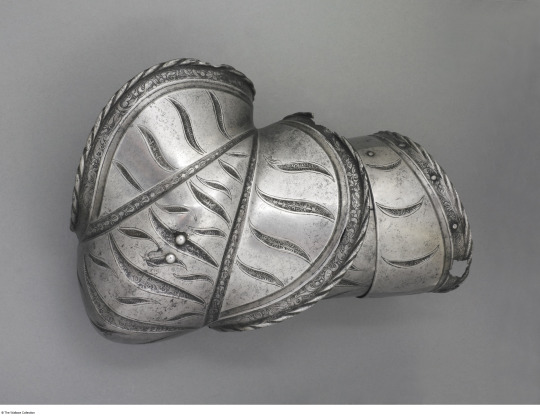
Recently, these pieces were assembled to show what the arm harness for field as a single unit would have looked like.
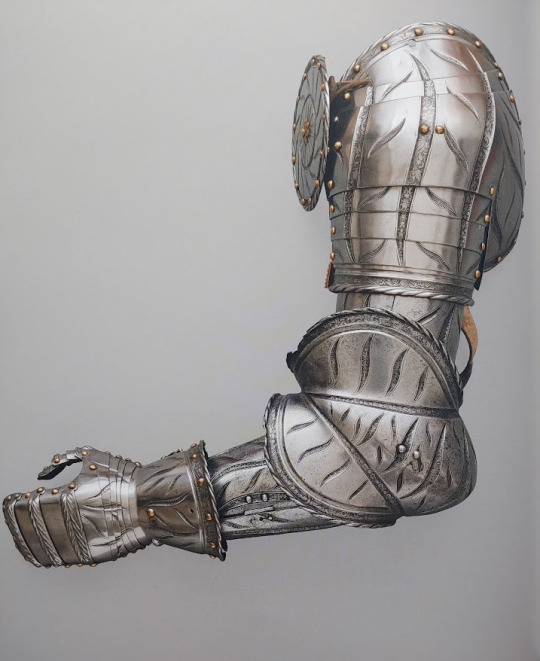
This armor would also have been accompanied by a gorget, now missing, and a helmet. Frequently, this armor is displayed alongside a close-helmet, however it is more likely the armor would have been accompanied by a burgonet similar in form to this example from the KHM.
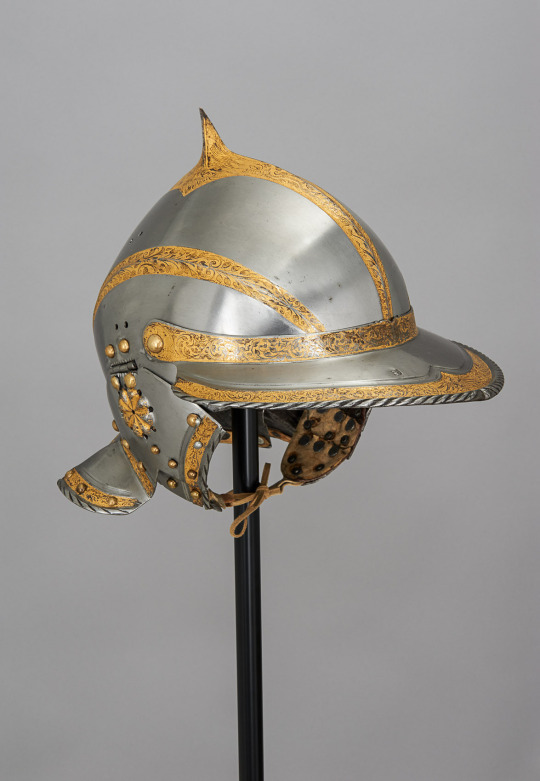
One final, unique surprise this armor holds is a hidden lance rest which is incorporated into the turned edge by the right arm. This rest folds down to allow a light lance to be braced atop it, and when folded up, is nearly invisible so as to not ruin the smooth surface of the breastplate with the prominent staples typically required for affixing a lance rest.

The third and final armor of this group is housed at the Metropolitan Museum of Art in New York City.

The least complete of these three armors, it may also be the most visually impressive. Comprised of only a backplate, hoguine, and arms, the puffs and slashes of this piece (also by Kolman Helmschmid and Daniel Hopfer) are ornately cusped. The slashed regions, displaying the gilded “fabric” beneath, and heavily etched to resemble an expensive silk brocade.
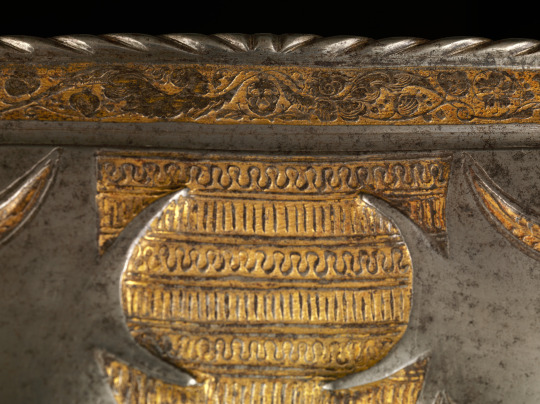
The sleeves of this armor are even more voluminous than those of the Rogendorf armor, though they are similarly articulated and provide the wearer with a surprising degree of mobility. It is thought that this armor may have been made for prominent Polish nobleman Jerzy Herkules Radziwill.
Interestingly, the hoguine of this armor is composed of two separate plates, rather than a single solid plate. Where the hoguine of the other two armors terminates in a decorative fabric border, the Met armor continues into two more articulated lames, covering the top rear of the thighs. Holes along the bottom edge suggest that this armor may have been accompanied by fully enclosing cuisses which pointed to the bottom of the fauld and hoguine.
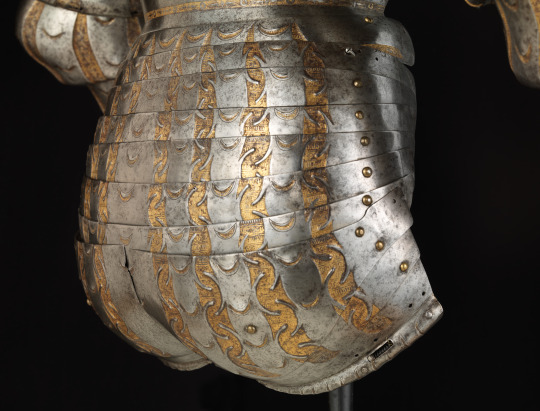
Sources
“A Pair of Gauntlets.” Kunsthistorisches Museum Wien. https://www.khm.at/de/object/540164/.
“A Pair of Spaulders with Besagews.” Kunsthistorisches Museum Wien. https://www.khm.at/de/object/372772/.
Cranach, Lucas the Elder. “Portrait of Duke Henry of Saxony.” Staatliche Kunstsammlungen Dresden. https://skd-online-collection.skd.museum/Details/Index/246875.
Krause, Stefan. Fashion in Steel. Vienna: Kunsthistorisches Museum, 2017.
“Landsknecht Costume Armour.” Kunsthistorisches Museum Wien. https://www.khm.at/de/object/372771/.
“Left Upper Cannon and Couter.” The Wallace Collection. https://wallacelive.wallacecollection.org:443/eMP/eMuseumPlus?service=ExternalInterface&module=collection&objectId=60736&viewType=detailView.
“Open Burgonet.” Kunsthistorisches Museum Wien. https://www.khm.at/en/object/503346/.
“Parts of an Armour.” The Wallace Collection. https://wallacelive.wallacecollection.org:443/eMP/eMuseumPlus?service=ExternalInterface&module=collection&objectId=60519&viewType=detailView.
“Portions of a Costume Armor.” The Metropolitan Museum of Art. https://www.metmuseum.org/art/collection/search/27790.
“Vambrace.” Kunsthistorisches Museum Wien. https://www.khm.at/de/object/372773/.
“Wilhelm von Rogendorf.” Kunsthistorisches Museum Wien. https://www.khm.at/de/object/1409642/
.
#long post#armor#armour#landsknecht#costume armor#art#history#renaissance#germany#german#hre#holy roman empire#europe#european#themet#metmuseum#khm#skd#wallace collection
1K notes
·
View notes
Text

Ropilla and breeches of a Conquistador, late 16th century
In 1932, German archeologists stumbled upon these garments while examining a native burial ground in modern day Peru. The breeches, made of wool, and the Ropilla, made of Peruvian cotton, were most likely worn by a (spanish) explorer who was laid to rest at the burial ground, before grave robbers looted his corpse and threw away his garments.
These garments are the only known examples of extant 16th century European clothing worn in South America. They are also among the few surviving worker´s/soldier´s clothes from this period. The breeches are especially simple - each leg is made of one quarter circle of fabric gathered at the waist.
These garments are exhibited at the Bayerischer Armeemuseum in Bavaria, Germany.
#historical fashion#16th century#historical costuming#renaissance#renaissance fashion#16th century fashion#fashion history#history#conquistador
44 notes
·
View notes
Photo

Inca Textiles
For the Incas finely worked and highly decorative textiles came to symbolize both wealth and status, fine cloth could be used as both a tax and currency, and the very best textiles became amongst the most prized of all possessions, even more precious than gold or silver. Inca weavers were technically the most accomplished the Americas had ever seen and, with up to 120 wefts per centimetre, the best fabrics were considered the most precious gifts of all. As a result, when the Spanish arrived in the early 16th century CE, it was textiles and not metal goods which were given in welcome to these visitors from another world.
Although very few examples of Inca textiles survive from the heartland of the empire, and we also know that many textiles were burnt to prevent them from falling into the hands of the Spanish, we do have, thanks to the dryness of the Andean environment, many textile examples from the highlands and mountain burial sites. In addition, Spanish chroniclers often made drawings of textile designs and clothing so that we have a reasonable picture of the varieties in use.
Weavers
It seems that both men and women created textiles, but it was a skill women of all classes were expected to be accomplished at. The principal equipment was the backstrap loom for smaller pieces and either the horizontal single-heddle loom or vertical loom with four poles for larger pieces, such as rugs and blankets. Spinning was done with a drop spindle, typically in ceramic or wood. Inca textiles were made using cotton (especially on the coast and in the eastern lowlands) or llama, alpaca, and vicuña wool (more common in the highlands) which can be exceptionally fine. Goods made using the super-soft vicuña wool were restricted and only the Inca ruler could own vicuña herds. Rougher textiles were also made using maguey fibres.
The finest female weavers (aclla) from across the empire were forcibly relocated to the capital Cuzco to work in the Acllawasi or 'House of the Chosen Women'. Here, too, state sponsored workshops with subsidised workers produced clothing for the nobility and the army. It was here that the finest cloth was made by male specialists known as qumpicamayocs or 'keepers of the fine cloth'. The Incas had three categories of cloth: the roughest was chusi (used primarily for blankets); slightly less coarse and most common was awasca for daily use and the military but which was rarely decorative; and the finest cloth was qompi. The latter was divided into a further two categories - one grade for tribute, the other for royal and religious function. Many burials contained not only textiles but also oblong work-baskets which contained the tools necessary for weaving (spindles, bobbins, spools of thread, and metal pins and needles), indicating that weaving was a highly esteemed craft.
Continue reading...
36 notes
·
View notes
Text
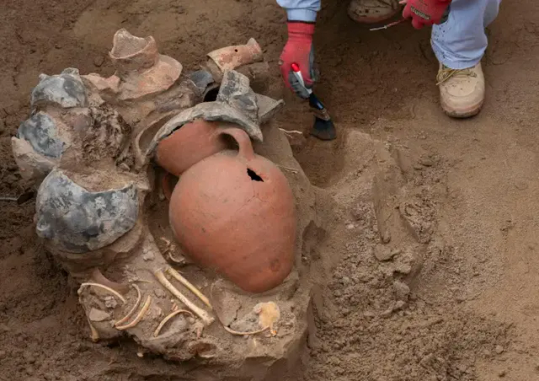
Eight Mummies and Pre-Inca Artifacts Discovered in Peru
Peruvian gas workers made an astonishing discovery beneath the ancient streets of Lima this week — uncovering eight mummies and a number of Pre-Inca artifacts.
“We are recovering those leaves of the lost history of Lima that is just hidden under the tracks and streets,” said Jesus Bahamonde, an archaeologist with Calidda, the company that distributes natural gas to the 10 million residents of Peru’s capital city.
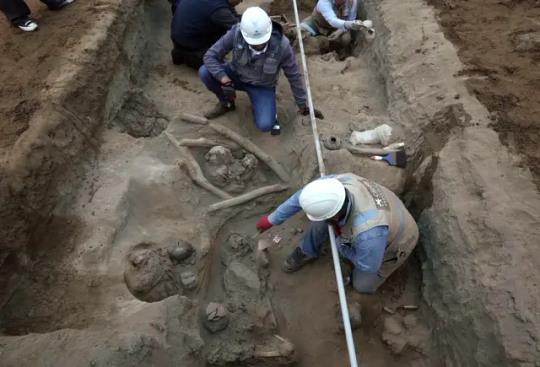
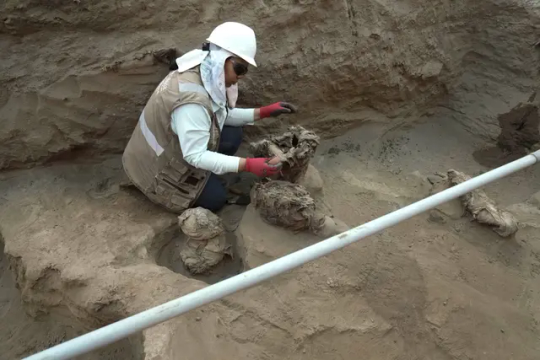
Since the company began expanding its gas line system nearly two decades ago, they’ve racked up more than 1,900 archeological finds — including mummies, pottery, and textiles, Bahamonde said.
In the most recent discovery, the eight mummified males were found bundled up in the trench, wrapped in cotton cloth and tied with ropes braided from vines. Workers found the bodies about a foot below the ground.
Archeologists with the gas company believe the men belonged to a pre-Inca culture called Ichma, which formed around A.D. 1100 and flourished in the valleys around Lima until it was absorbed into the Inca Empire in the late 15th century.
Roberto Quispe, an archeologist who worked in the trench, sad the mummified bodies are likely two adults and six minors.
Lima, now an urban economic hub, has been occupied by humans for more than 10,000 years, from the Pre-Incan cultures to the Spanish conquistadors who claimed the land in the 16th century.
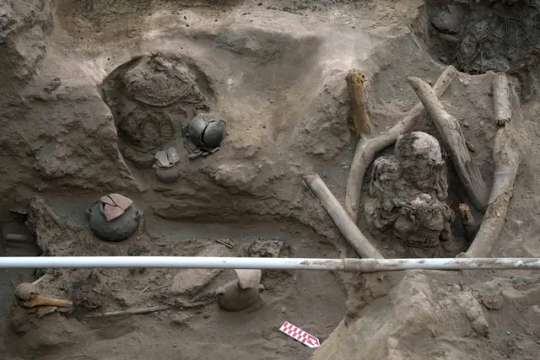
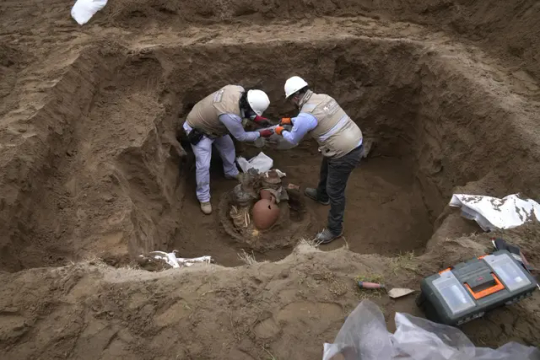

Many archeological finds have proven to be from more recent times.
In 2018, Quispe and other archaeologists working in the La Flor neighborhood found wooden coffins holding three Chinese immigrants buried in the 19th century.
The bodies were found alongside opium pipes, hand-rolled cigarettes, shoes, Chinese playing cards, a Peruvian silver coin minted in 1898 and a certificate of completion of employment contract, written and Spanish and dated 1875.
The eight mummies were found amidst braised chicken restaurants and a road that leads to Peru’s only nuclear power station.
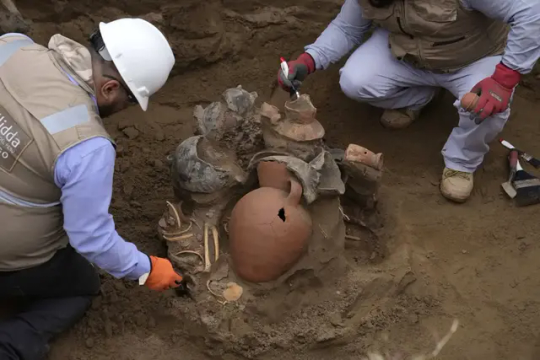
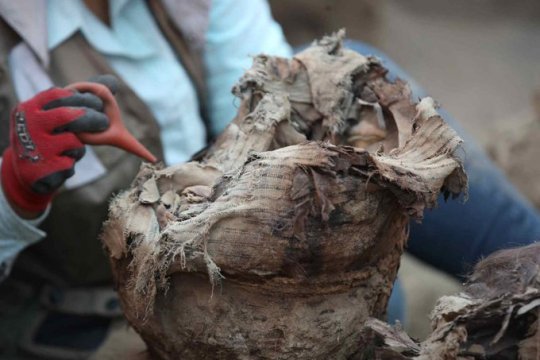

“When the Spaniards arrived in the 16th century they found an entire population living in the three valleys that today occupy Lima … what we have is a kind of historical continuation,” Bahamonde said.
Most of the archaeological sites uncovered by Calidda have been burial sites discovered on flat ground, Bahamonde said.
Aso scattered throughout the urbanized city are more than 400 larger archeological sites, known in the indigenous Quechua language as “huacas,” which are sacred adobe constructions typically found on hilltops.
By Patrick Reilly.

#Eight Mummies and Pre-Inca Artifacts Discovered in Peru#Lima Peru#ancient grave#ancient tomb#ancient artifacts#archeology#archeolgst#history#history news#ancient history#ancient culture#ancient civilizations#Inca history#Ichma history
56 notes
·
View notes
Text
Prove it
Version of my only other Namor x reader one shot with the dialogue in English.(spanish dialogue)
Gif by @unicornspwnall

You weren’t born yesterday.
There was no possible way for this fucking historical hotel was truly haunted.
There was no cool poltergeist, no ghost ladies giggling in the floral room where the hacienda’s owner’s daughter died suddenly in the eighties, and there was no fucking way there were Mayan Warriors with blue skin led by fucking K’uk’ulkan himself to pay homage to the big rock in the garden.
That had to be some idiot they had hired from town.
You bet your shitty paycheck you knew that dumbass in the slutty green shorts.
“How much are the paying you to do this bullshit every December?” you ask as the man stares at you in horror.
“What?” the man asks before cursing you in Yucatec Mayan, an older type with like no Spanish in it whatsoever.
But it’s still the same language, so you insult him back, which makes it worse.
Especially when you slip back into Spanish and he acts like you just spat in his face.
“This is my mother’s sacred grave!” he shouts at you in Spanish, but you don’t buy it. He is too real looking to be a ghost, that vein popping out on his forehead and the way he gets close enough for you to feel the warmth of a human being lecturing you on your rudeness.
“Yes, I know that is the grave of a woman, but I seriously doubt a woman in the 16th century has a , I don’t know, thirty year old son in the year 2020.” You cross your arms and stand your ground.
Would he be offended if you ask him out for drinks at the shitty hotel cantina once you two get over this?
“And if I told you I am over five hundred years old?” he continues with the farce, and you wonder if its worth it to have another wannabe actor fuck buddy here.
“I’d say you look pretty fit for a five-hundred-year-old geezer, but I’d sooner believe that you get five hundred pesos to show up in such little clothing every fucking winter.” You answer with a scoff, five hundred pesos was a shit rate, that was barely fifty dollars. The cute girl from the local University got paid twice that to do her fake shaman tarot reader bullshit every month.
This fucker should ask Rigo the Owner for more.
He laughs, a slightly bitter thing that tells you he is this close to just killing you outright.
He is handsome, you give him that. And well endowed, which is probably why Rigo’s slutty much younger wife chose him.
The feathers and his outfit look legit, too real, especially the fake jade jewelry. You had to hand it to him, the nose plug and the earrings looked pretty fucking good.
“I would kill you, but I wouldn’t dishonor my mother’s grave with the blood of an idiot who can’t see the difference between a human man and the god, K’uk’ulkan!” he exclaims and you think he may be right.
If the Norse had sexy Thor and whatever his goth brother was, if the Americans can defrost Captain America like frozen meat, maybe, just maybe the weirdo standing here was the Serpent God of Mesoamerica.
Could explain why he looked the same in all the photos since cameras were invented.
Could the man you’ve infuriated so much that he stands there breathing hard and clenching his fists to avoid hitting you be the god, K’uk’ulkan?
“If you really are a god… then prove it.” You say goading him into proving he was fraud. If he is a fraud, he will do anything to make you forget it, like kiss you in anger and get the two of you fired for hate fucking where some of the guests can see you.
You hope he is a fraud; it has been so long since you’ve had a good fuck.
He smiles, one that makes you shake in your metaphorical boots, as he took you by the waist and flew with the weird little wings on his ankles.
“Holy fuck.” You utter as he flies you to the beach.
159 notes
·
View notes
Text
Jeyne Poole - Fancasts
Age: 10/11 - 13/14
Appearance: She’s pretty with brown eyes and dark hair. She is skinny with nice white teeth.
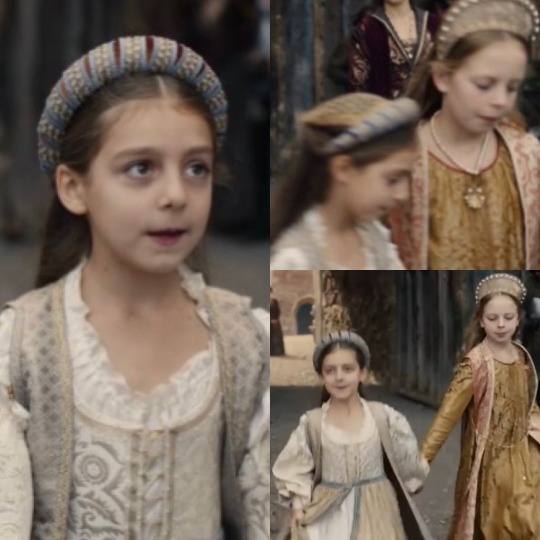
Character: Anne Boleyn [Younger]
Actress: Unknown
Show: Spanish Princess [2019] [Season 1 & Ep 7]
[Unknown Age, looks to be around 9 - 11 so around the right age for her at Kings Landing or Winterfell. She is pretty and skinny with brown eyes. She also has dark hair. She wears Tudor ish clothes.]
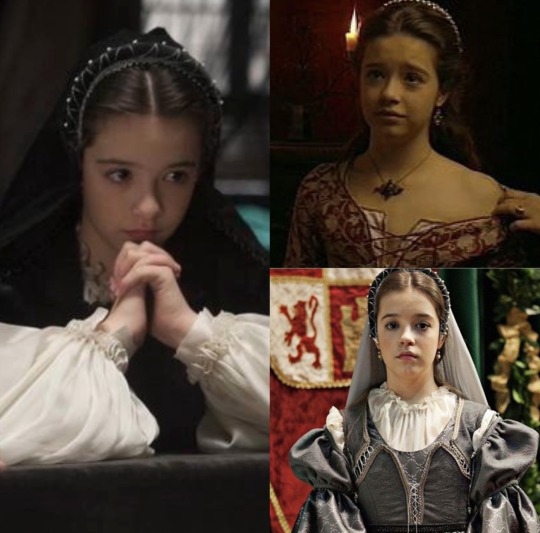
Character: Julana’la Beltraneja
Actress: Carmen Sanchez
Show: Isabella [2012] [Season 1 & 2]
[She was 10/11 - 11/12 during these seasons so the right age for Jeyne from when he first meet her till her marriage to Ramsay. She is skinny and pretty with brown eyes plus dark hair. She wears 15th century clothes.]
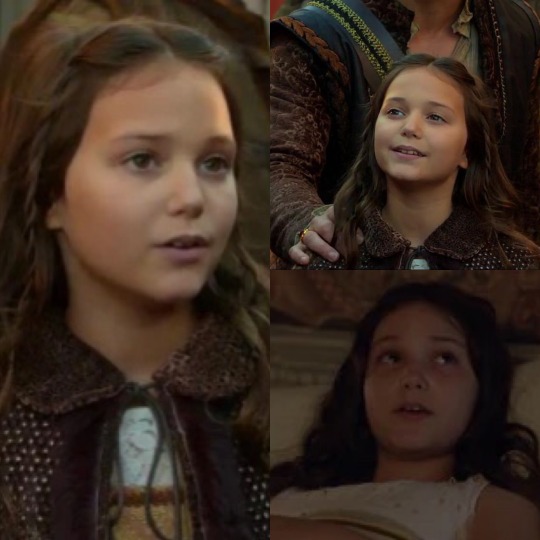
Character: Agatha Blackburn
Actress: Macy Drouin
Show: Reign [2013] [Season 3 & 4]
[Unknown Age, looks good be around 11 - 13 so the right age for Jeyne when we first meet her to her marriage to Ramsay. She is skinny and pretty with brown eyes plus dark hair. She wears vaguely 16th century clothes.]
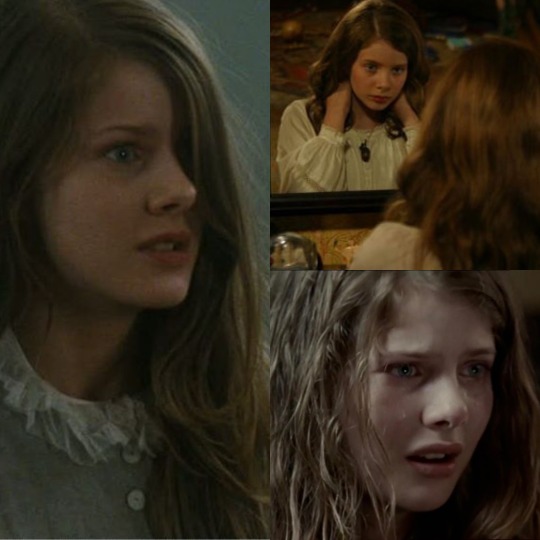
Character[s]: Betsy Bell, Wendy Darling & Imogen Helhoughton
Actress: Rachel Hurd-Wood
Movie[s]: An American Haunting [2005], Peter Pan [2003] & Sherlock Holmes and the Case of the Silk Stocking [2004]
[She was 12/13 during Peter Pan so would be good for when she was forced into sex work. She is 13/14 in the Sherlock Holmes scene so good for her during/after her marriage to Ramsay. She is a slightly too old for Jeyne currently in an American Haunting at 14/15 but I think she would be good for her in TWOW. She is pretty and skinny but does not have brown eyes plus her hair isn’t that dark. She wears early 20th century plus fantasy clothes in Peter Pan. She wears early 20th century undergarments in her scene in Sherlock. She wears 19th century clothes in An American Haunting.]
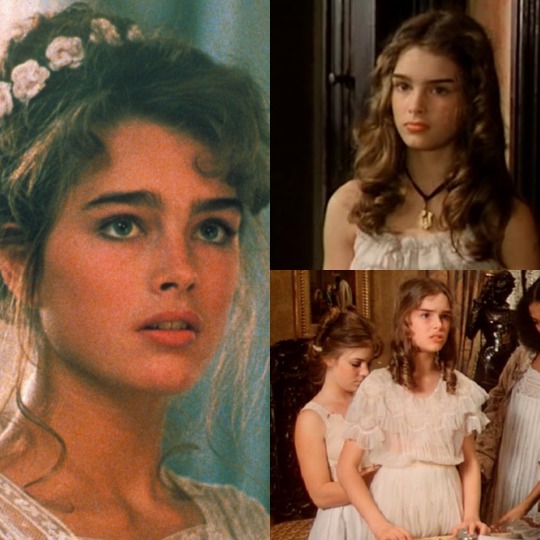
Character[s]: Jade Butterfield & Violet
Actress: Brooke Shields
Movie: Endless Love [1981] & Pretty Baby [1978]
CW/TW: Child Nudity & Violence [Would recommend just using clips off YouTube instead of watching these disgusting movies]
[She was 12/13 during Pretty Baby so the right age for when she was forced into sex work and during her marrying Ramsay. She is 15/16 during Endless Love so too old for Jeyne but I only like this movie the scenes with the flowers in her hair. She is pretty and skinny with brown eyes and dark hair. She wears early 20th century clothes in Pretty Baby & modern in Endless Love.]

Character: Diana Barry
Actress: Dalila Bela
Show: Anne with an E [2017]
[She is far too old at 16 - 18 but her character is around the same age as Jeyne. She is skinny and pretty with brown eyes plus dark hair. She wears 19th century clothes.]
#please suggest other fancasts#jeyne poole#jeyne poole fancasts#jeyne poole fancast#asoiaf fancast#a song of ice and fire#asoiaf#fancast resource#game of thrones
70 notes
·
View notes
Text

JFK and his not-homoerotic thoughts on slutty 16th century spanish clothes
(PonceFK in my head never leaving)
#Clone high#clone high jfk#ch jfk#clone high ponce#Ch Ponce#Poncefk#Clone high poncefk#i do things#I love HEMA I am sorry (I am not sorry)#Did you know the OG JFK had Auburn hair??? Gingerish JFK is making me insane#2023
73 notes
·
View notes
Text

The Maya civilization used chocolate as money
Art suggests that cacao beans were a valued currency
Your Hershey bar may have been worth its weight in gold in Mayan times. A new study reveals that chocolate became its own form of money at the height of Mayan opulence—and that the loss of this delicacy may have played a role in the downfall of the famed civilization. The study is on the right track, says David Freidel, an anthropologist and Maya expert at Washington University in St. Louis, Missouri, who was not involved with the work. Chocolate "is a very prestigious food," he says, "and it [was] almost certainly a currency." The ancient Maya never used coins as money. Instead, like many early civilizations, they were thought to mostly barter, trading items such as tobacco, maize, and clothing. Spanish colonial accounts from the 16th century indicate that the Europeans even used cacao beans—the basis for chocolate—to pay workers, but it was unclear whether the substance was a prominent currency before their arrival...
Read more: https://www.science.org/content/article/maya-civilization-used-chocolate-money
Photograph by Everjean
20 notes
·
View notes
Note
Hello!
I hope you're doing well. I am very lucky to have stumbled across your blog. I am currently working on my dissertation which is about the Spanish colonisation of the archipelago of the Philippines till, particularly, 1700. I am focusing on the cultural impact that colonisation had in terms of art, architecture, music, theatre, language and literature. Could you share any academic articles or publications that I could make use of?
Thank you!
the first thing that comes to mind is clothing the colony by stephanie coo. unfortunately, it focuses on the century after your point of interest however the early chapters do lay down some relevant background information and context leading up to the thesis of the book which is about sartorial culture in spanish philippines.
another thing that might interest you in terms of women’s history in particular (and is a bit more period appropriate, i.e., before AD 1700) is the flaming womb by barbara andaya. it’s about trends and societal shifts throughout the broad southeast asian region from the early modern era and beyond but there are some bits there that pertain to the philippines, women in religion, and christianity that might interest you.
another is the myth of the lazy native by syed hussein alatas. the subtitle - “A study of the image of the Malays, Filipinos and Javanese from the 16th to the 20th century and its function in the ideology of colonial capitalism” - explains the book very well.
sorry for the not-so exhaustive list. most of my interest in philippine history and cultures are concentrated on mindanao history, prehispanic / classical / early modern eras, and prehistory!
11 notes
·
View notes
Text
Amaranth🪻
eng

Amaranth is a superfood that has been nourishing the human body for centuries, dating back to the pre-Hispanic era in Mexico. Amaranth was a staple food of the Aztecs and was believed to have been given to them by the gods. The plant was so revered that it was often used in religious ceremonies, including the famous Aztec New Year festival. It was ground into a flour and used to make a type of bread called "tzoalli" or "amaranth bread." When the Spanish arrived in the 16th century, they banned the use of amaranth because of its association with the Aztec religion. However, the plant persisted in Mexico and has been a traditional food ever since. Amaranth was not only a food source in pre-Hispanic times, this grain was used to make a dye for textiles and body paint in pre-Hispanic times.


The Aztecs, in particular, used the plant to produce a reddish-purple dye for their textiles. They would grind the seeds into a fine powder, mix it with water, and apply it to the fabric. The resulting color was so vibrant and long-lasting that it was often used to decorate the clothing of royalty and other important figures.
The use of amaranth as a dye and body paint reveals the plant's cultural significance in pre-Hispanic times. The deep red pigment created from the plant was not just a form of decoration or cosmetic enhancement but also a symbol of religious and spiritual beliefs. The Maya people believed that the color red represented the blood of their gods and ancestors, and by adorning themselves with the pigment, they were able to connect with their spiritual beliefs and honor their deities.

Amaranth was not just a food staple for the Aztecs, but it also played a big part in their worship. They built statues of their deity using amaranth grain and honey. These statues were worshipped, broken, and distributed for eating. This practice is the primary reason amaranth did not survive as a staple.
When the Spanish arrived with Cortez, as part of their efforts to force Christianity on the pagan natives, they outlawed the grain. Amaranth fields were burned and cultivators were punished. Lucky for us, they were unable to completely destroy the grain. In a few remote areas, small amounts of amaranth survived.
2 notes
·
View notes